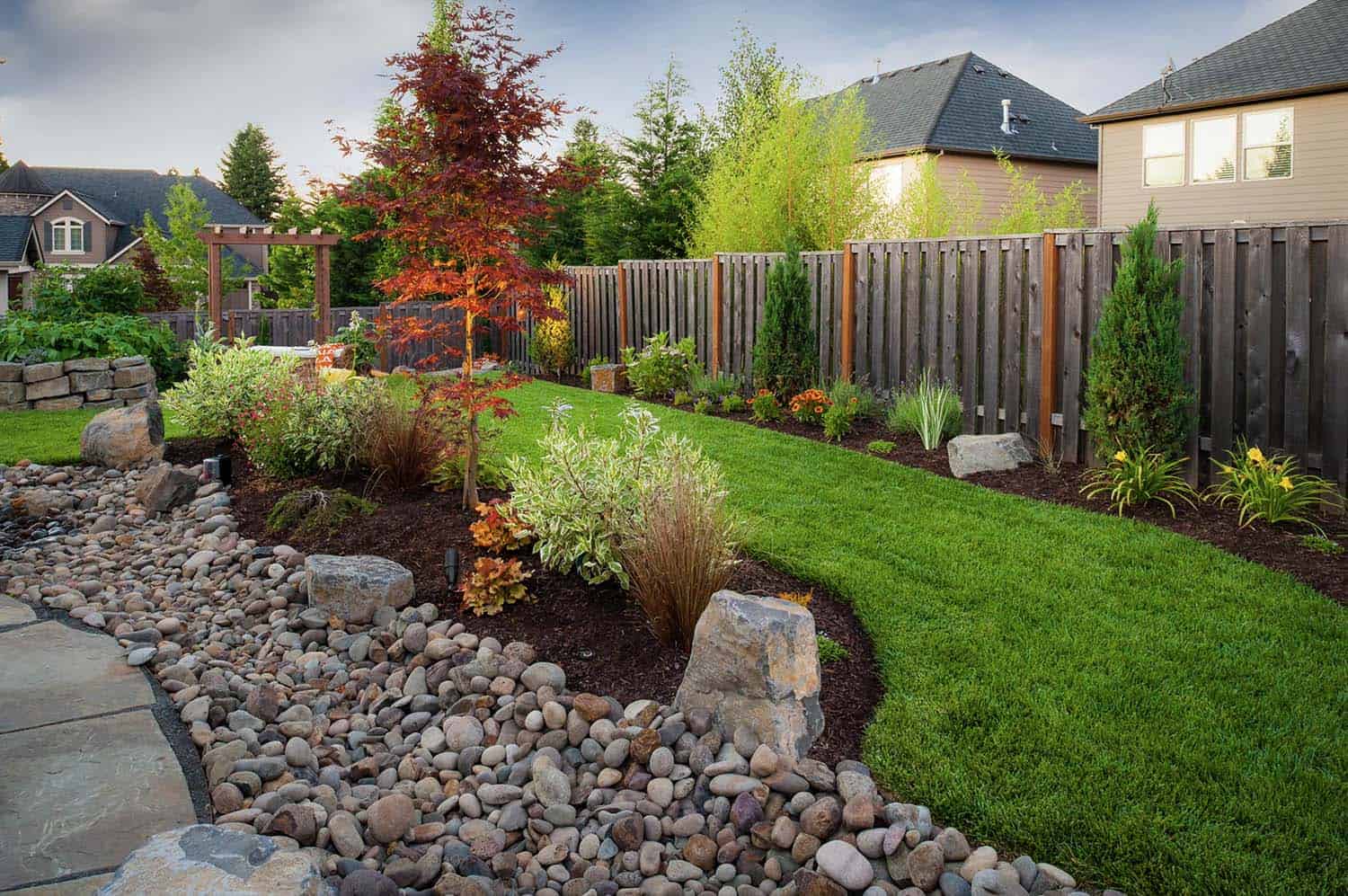Elevate your garden with river rocks! These versatile stones can create stunning features like Zen gardens, water elements, paths, ponds, and raised beds.
Discover inspiring ideas—from classic to creative—to transform your outdoor space.
Find inspiration below, along with tips on choosing and using river rocks to craft your own beautiful garden paradise.
Stone Path
:max_bytes(150000):strip_icc():format(webp)/rrFotosearchgetty-668b7c47c3924fc5a93a129a74b1ebbd.jpg) Fotosearch / Getty Images
Fotosearch / Getty Images
This stone path combines two sizes and colorways of river rock (tan pea gravel and grey stones) with large natural pavers.
Dividers separate mulched areas from gravel to keep things looking neat.
Gravel Patio
:max_bytes(150000):strip_icc():format(webp)/rrDesignByBrookside-d4cec1f4dbf84503b0470afa1d793422.jpg) @designbybrookside / Instagram
@designbybrookside / Instagram
This minimalist-style seating area features a long fire feature and modern wicker chairs on a simple pea gravel patio.
Installing landscape edging made of granite and slabs for stairs makes for a sleek, clean look.
Dry River Bed for Drainage
:max_bytes(150000):strip_icc():format(webp)/rrigstone.warehouse-7195708ef7dd4deeaec9df28a147f10d.jpg) @stone.warehouse / Instagram
@stone.warehouse / Instagram
If your property has drainage issues, or sloping areas where run-off is a problem, creating a dry river bed can help, in addition to being a beautiful addition to your landscape.
This version uses different sizes of river to create a stable bed, and is anchored further with lush plantings.
Gravel Fire Pit Area
:max_bytes(150000):strip_icc():format(webp)/rrarnettd-8f8005d6b0604eea852aa5aecb7efc9f.jpeg) @arnettoutdoordesign / Instagram
@arnettoutdoordesign / Instagram
This path ending in a round seating area is a clever use of space in this narrow yard.
The shrubs provide privacy and the ending keeps the gravel in place.
The stone fire dish completes this simple, functional design.
Patio Container Garden
:max_bytes(150000):strip_icc():format(webp)/rrmcfarlaneig-6cb474ff84c64fc7b3aa056bc85ee862.jpg) @teddy_macfarlane / Instagram
@teddy_macfarlane / Instagram
If you long for an outdoor garden space but don’t have good soil or time for maintenance, consider a gravel patio seating area with potted plants.
This one also has oblong wood planters with Mediterranean herbs.
Pea Gravel Path
:max_bytes(150000):strip_icc():format(webp)/rriglorenovation-5bed3b14952f4c9ea9fb4df1af2d7e0d.jpg) @lorenovation / Instagram
@lorenovation / Instagram
Once your surface is level, making a gravel path only requires some landscaping fabric, an optional layer of sand, some rocks or bricks for edging, and a rake to spread the gravel.
It’s a project that can be done in a day and will vastly improve the form and function of your garden.
Pea gravel makes for a comfy, ergonomic walking surface too.
Colorful River Rock Garden
:max_bytes(150000):strip_icc():format(webp)/rrSutidaSgetty-97b20d39e7844c1b93df7459662c51ce.jpg) SutidaS / Getty Images
SutidaS / Getty Images
Your local supplier may have a wide variety of sizes, textures and colors available for a rock garden, including matte surface river rock or shiny stones, and colors ranging from white to black, grey, tan, blue, purple or even pink.
Pea Gravel Driveway
:max_bytes(150000):strip_icc():format(webp)/rrelliottkaufmangi-fdfd0c7140094c07a4d3421cada93af7.jpg) Elliott Kaufman / Getty Images
Elliott Kaufman / Getty Images
Gravel is an excellent easy to use material for a driveway or walkway and can be simpler to maintain than asphalt in areas that freeze in winter.
Gravel’s lighter colors also provide a different and somewhat warmer aesthetic compared to blacktop.
The pea gravel here works well with the large slates to create a patio area at the entrance to this house.
Rock Garden + Groundcovers
:max_bytes(150000):strip_icc():format(webp)/rryanikapGetty-8bc21feb242542a4b00db5bea5b11d52.jpg) yanikap / Getty Images
yanikap / Getty Images
An easy and attractive garden design can be made with pea gravel, larger river rocks, and a selection of creeping groundcovers.
Choose groundcovers that like good drainage and don’t need too much water, like creeping phlox, creeping sedums, dianthus, and creeping bellflowers/campanula.
These are all perennials that can be deadheaded and divided easily.
Weed-Free Flower Beds
:max_bytes(150000):strip_icc():format(webp)/rrMunolegetty-ad58a44eea3f494981e8d181048abc13.jpg) Munole / Getty Images
Munole / Getty Images
This flower bed-in-progress uses landscaping fabric with holes for plants and river rock gravel instead of mulch for a clean look that works to keep weeds at a minimum.
Not all plants are suited to this type of planting, and prefer a more traditional soil culture.
But many plants adapt well, including many shrubs, and most drought-tolerant plants such as sedums and salvias.
Gravel Patio + Groundcover
:max_bytes(150000):strip_icc():format(webp)/rrigrow_hill_holidays-bab56133b1e14295812a6674f1988a0f.jpg) @row_hill_holidays / Instagram
@row_hill_holidays / Instagram
Sometimes you want the view to command your full attention.
That calls for keeping your landscaping plan simple: a gravel patio, a couple of low-maintenance ground cover plantings, and seating to enjoy your surroundings.
River Rock Water Feature
:max_bytes(150000):strip_icc():format(webp)/rrfotovideostudio-95351e85a3d047748f13bf2240229505.jpg) Foto-Video-Studio / Getty Images
Foto-Video-Studio / Getty Images
River rocks are a great choice to use in building a water feature, because their smooth surfaces catch the light so well as water trickles over them.
Gravel + Granite Patio
:max_bytes(150000):strip_icc():format(webp)/Solidagorr-905c3ad19cbd4fc39e4a6d43c7864970.jpg) Solidago / Getty Images
Solidago / Getty Images
The gravel and granite boulders in this seating area provide a neutral backdrop for the bright red chairs and plantings of Russian sage and red bee balm in this pollinator friendly garden.
Zen Rock Garden
:max_bytes(150000):strip_icc():format(webp)/rrzengetty-8365e4f5953a477a9be6b572dda85d11.jpg) Adastra / Getty Images
Adastra / Getty Images
Traditional zen rock gardens in Japan can be very large but you can create a smaller version in your yard using pea gravel and larger stones.
The design is meant to display symbolic elements of nature, like the rippled lines in gravel representing ocean waves. using rounded river rock gravel will give your zen garden a smooth texture.
Decorative Planter Accents
:max_bytes(150000):strip_icc():format(webp)/rrgettyhi-point-0ea1f217ac244a649d0576ff28c471e3.jpg) Hi-Point / Getty Images
Hi-Point / Getty Images
Using river rock as a decorative accent in your plants lets you play with colors, shapes and textures on a smaller scale.
Pebbles can also help anchor plants in place and retain moisture.
Xeriscape Pea Gravel
:max_bytes(150000):strip_icc():format(webp)/rrbearigul-10a74491fd024b9f9b4f002a7aed494b.jpg) @beartrapgarden / Instagram
@beartrapgarden / Instagram
Xeriscape gardening in areas with low rainfall is a good fit with river rock design.
Succulents, cacti and creeping drought-tolerant plants like the euphorbia pictured here do very well in a bed of pea gravel.
Stone holds heat and cold, so this desert garden will also cool off nicely at night helped by the stone’s excellent conducting properties.
Succulent Rock Garden
:max_bytes(150000):strip_icc():format(webp)/rrspikyigjpeg-512eaf7084ac4805a04f644a374e4c8b.jpg) @spiky_obsession / Instagram
@spiky_obsession / Instagram
Succulents do very well with minimal soil and in fact grow very well in gravel.
Being natives to desert climates, these plants thrive with the excellent drainage and heat preservation that a rocky environment provides.
They’re versatile for design, too, available in a range of sizes, shapes and colors.
Stone Sculpture
:max_bytes(150000):strip_icc():format(webp)/rrjunhaog-88cf3ebb193c4932905f45a618da43d8.jpg) JUNHAO / Getty Images
JUNHAO / Getty Images
Many river rocks have flat sides making them easy to stack up and form sculptures.
These can be made with rocks of virtually any size, and can be placed throughout your garden, on a table or next to your entrance.
River Rock Pet Patio
:max_bytes(150000):strip_icc():format(webp)/rrigbear-93137d64a0e8486faa0d8bcf2e04401b.jpg) @beartrapgarden / Instagram
@beartrapgarden / Instagram
You’ve probably noticed your dogs and cats love to spend time in the garden on a sunny day.
Having gravel surfaces that hold onto the heat provides a nice place for them to lie down on a cooler day, and as a bonus, they’re not as likely to get dirty.
River Rock Grass Border
:max_bytes(150000):strip_icc():format(webp)/rrkatkovg-d28de391c5c34838af77dfcca5b7daf8.jpg) katkov / Getty Images
katkov / Getty Images
Combining river rock gravel and small boulders with clumping native grasses is a simple, low-maintenance, and striking garden plan.
This one has smooth pea gravel and smooth rocks for edging, with rougher rocks placed among the plants for texture.
Rock Garden Idea
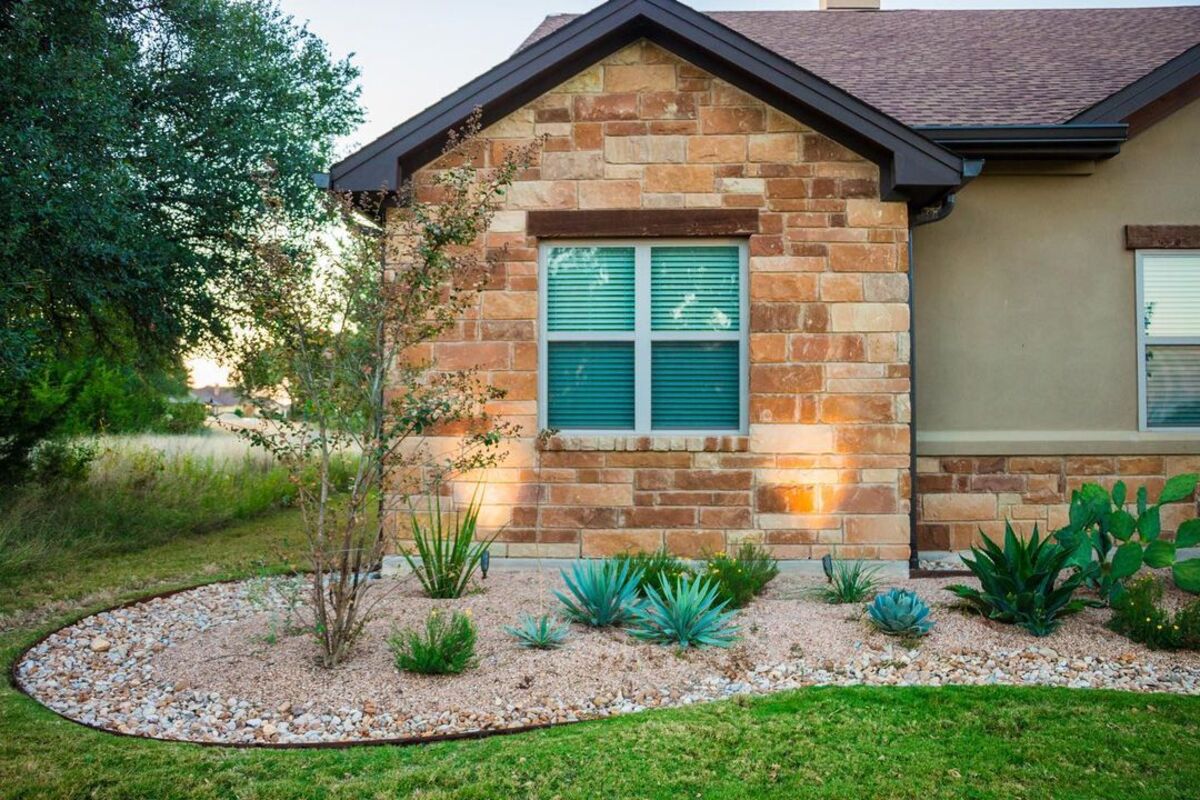
Succulent varieties feel great in gravel beds, being native to desert climates.
Gravel and river rocks combined create a lovely garden layer that enhances curb appeal and ensures good drainage for the plants in the rock garden.
Garden Bed Around The Exterior Walls
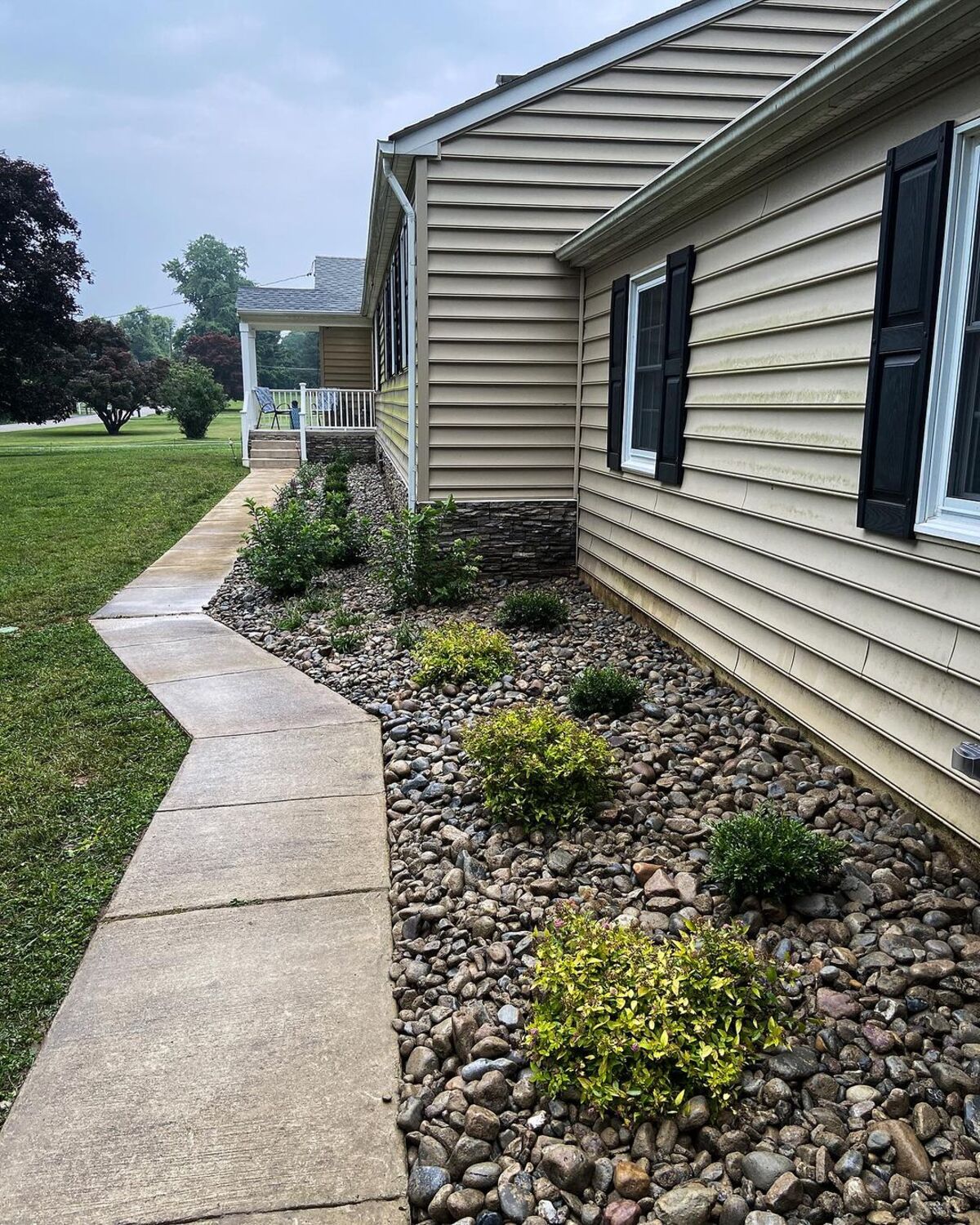
If you want to create interest in the exterior of your home, try a xeriscape design with river rocks.
You can take advantage of the versatility of the rocks and gravel and create a unique garden bed around the exterior walls.
Xeriscaping will also facilitate water drainage next to the house bases, where water can be very harmful.
Long Dry Creek Idea
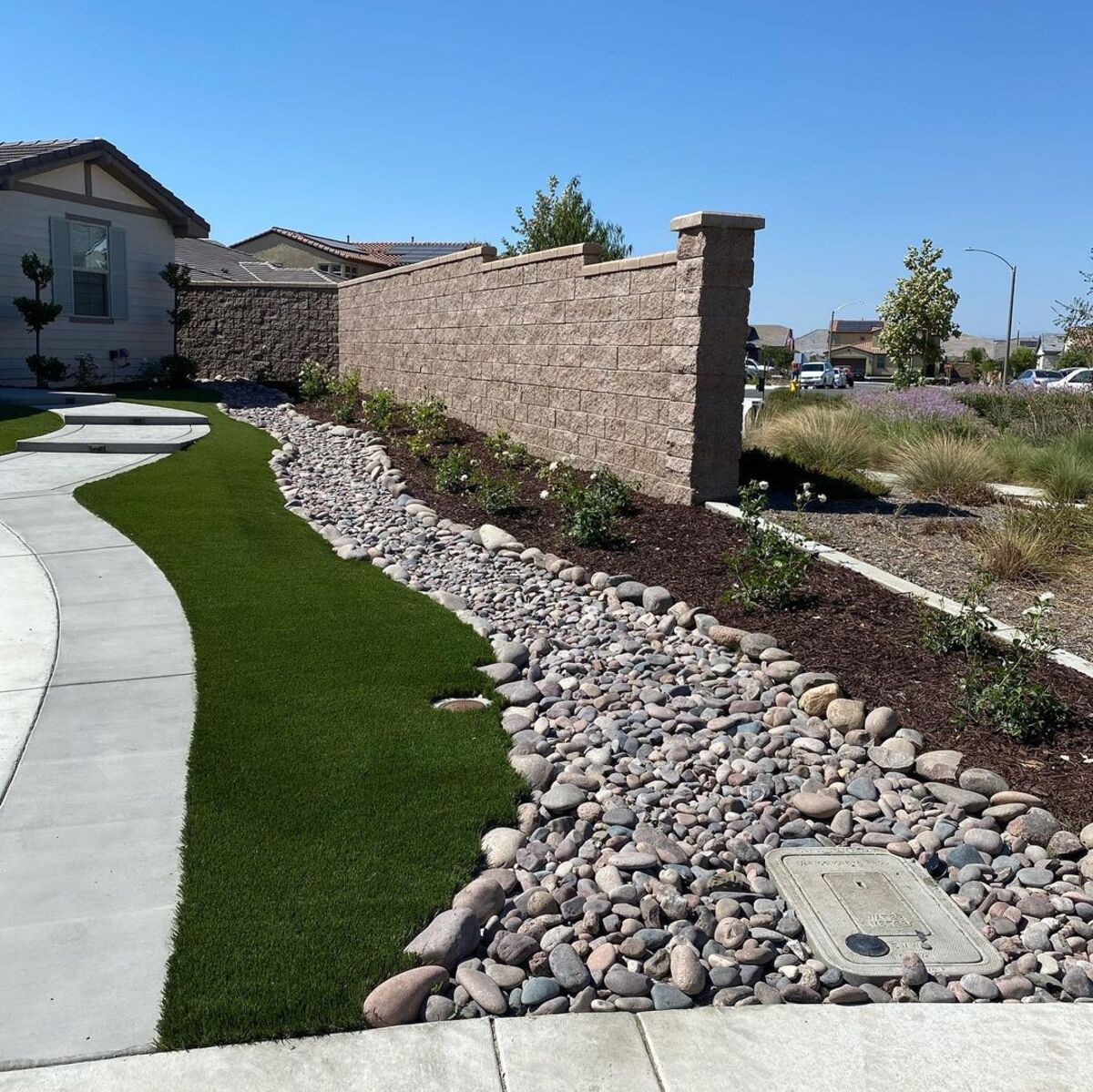
River rocks are a very popular material for shaping a dry river bed in the garden.
Use different sizes of rocks for the border and the creek filling, aiming to mimic the flow of a river.
Make the dry creek next to a mulch garden or a lawn to create contrast for the rocks and enhance the appeal of the dry creek.
River Rocks In A Walkway Design
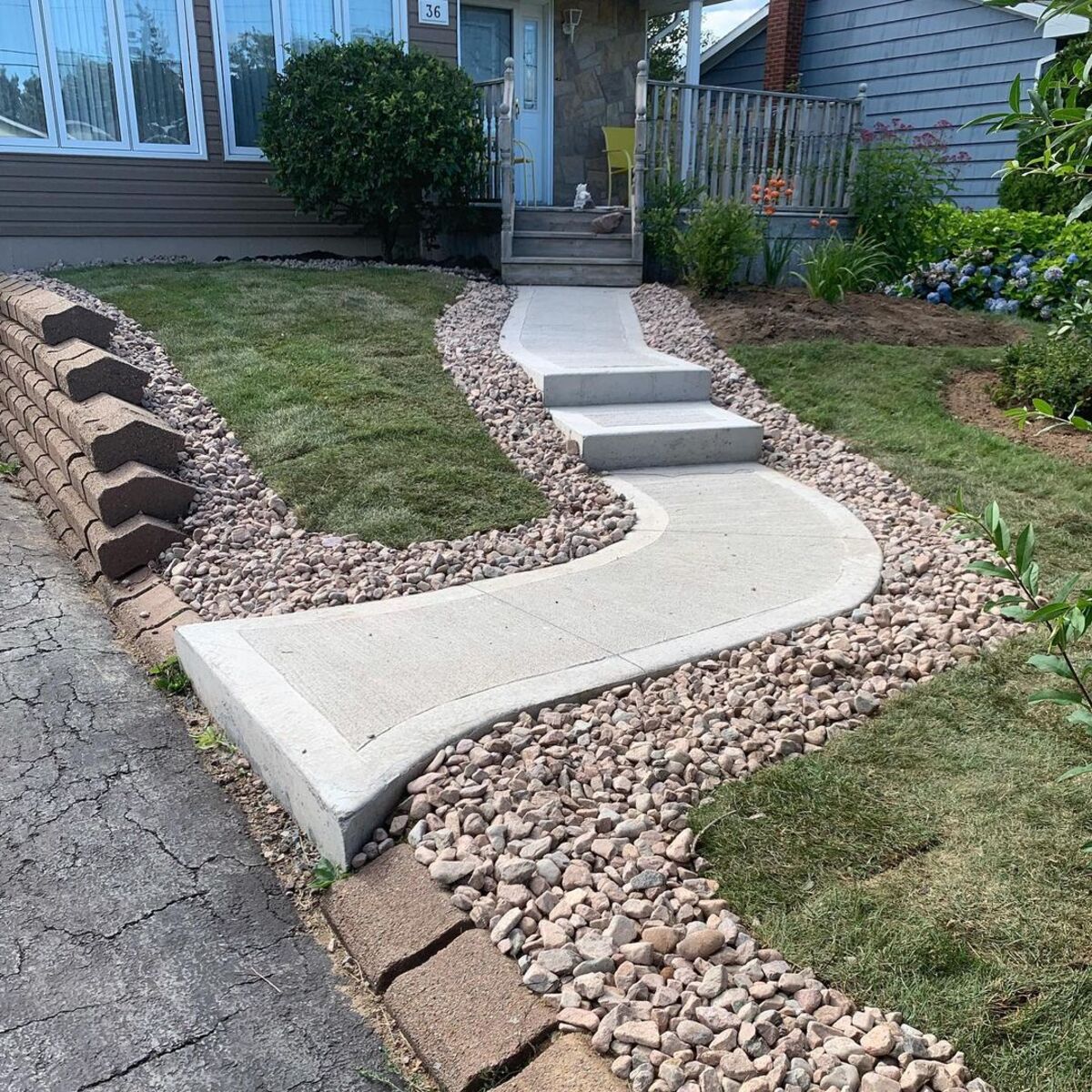
River rocks can be very helpful in creating a beautiful border between two landscape features.
Here, the river rocks differentiate a garden from a curved concrete pathway.
Being natural, they act as the perfect blend between the artificial walkway and the green living carpet.
Shrub Garden Bed
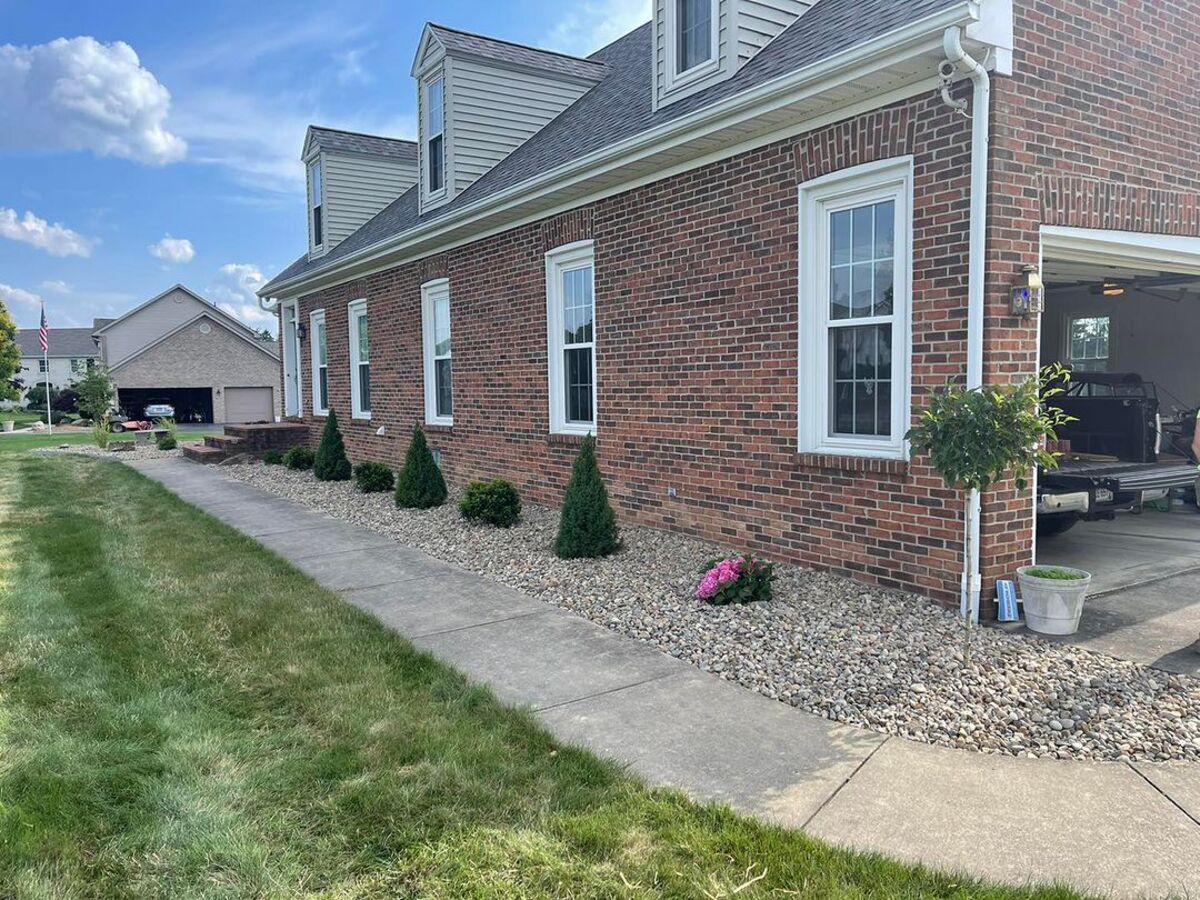
River rocks are inexpensive and preferred material for garden landscapes when the aim is to create interest.
In this river rock landscaping idea, the stones cover the top of an edging garden bed.
The plant varieties are evergreen shrubs that contrast with the white and grey color of the stones.
Stone Walkway
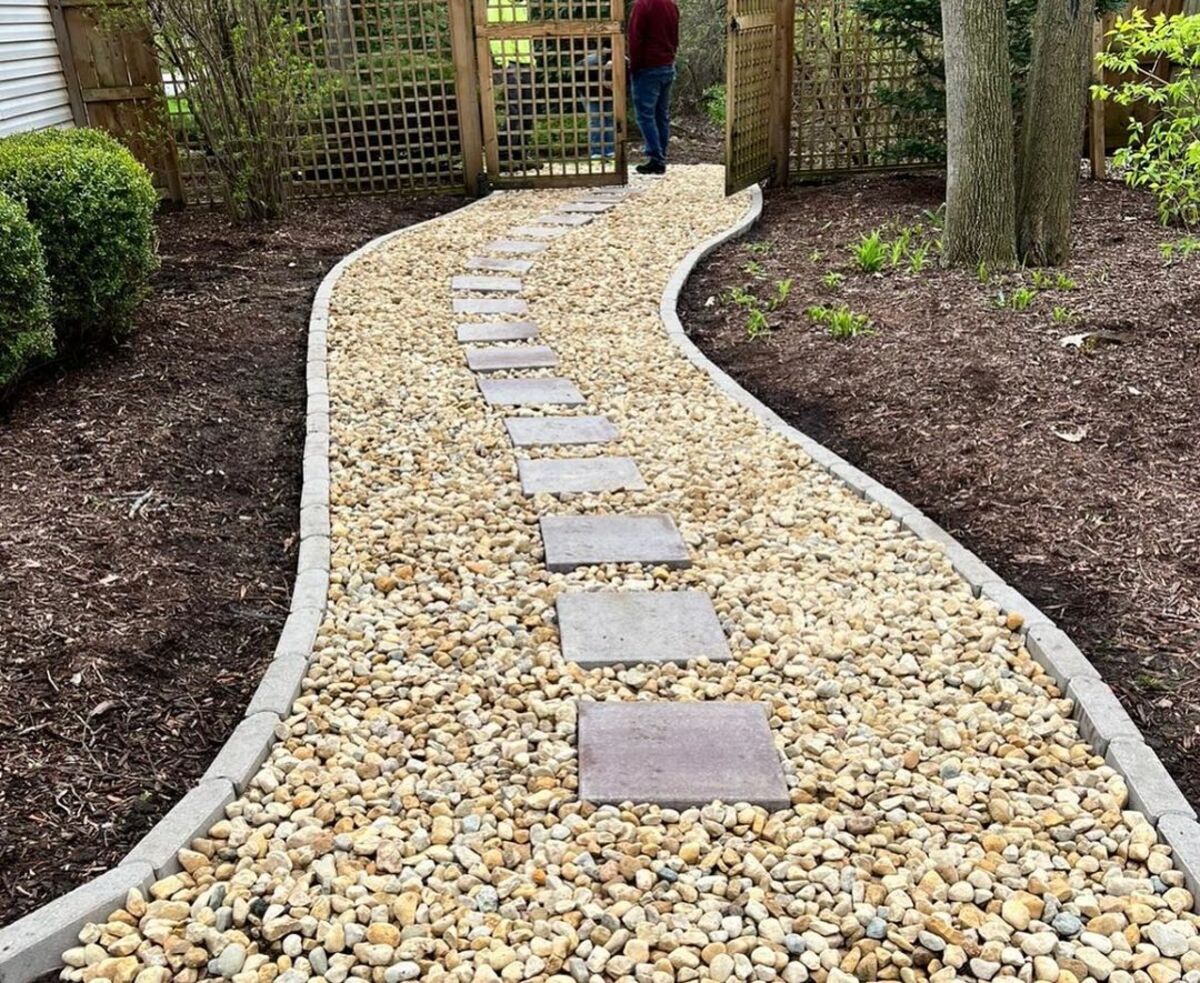
This curved garden pathway combines white and creamy gravel and grey stone tiles.
Pavers are aligned at the two sides of the walkway to create natural dividers between the walkway and the adjacent mulch garden.
These materials maintain a neat and organized outdoor space that is also eye-pleasing.
River Rocks As Ground Cover
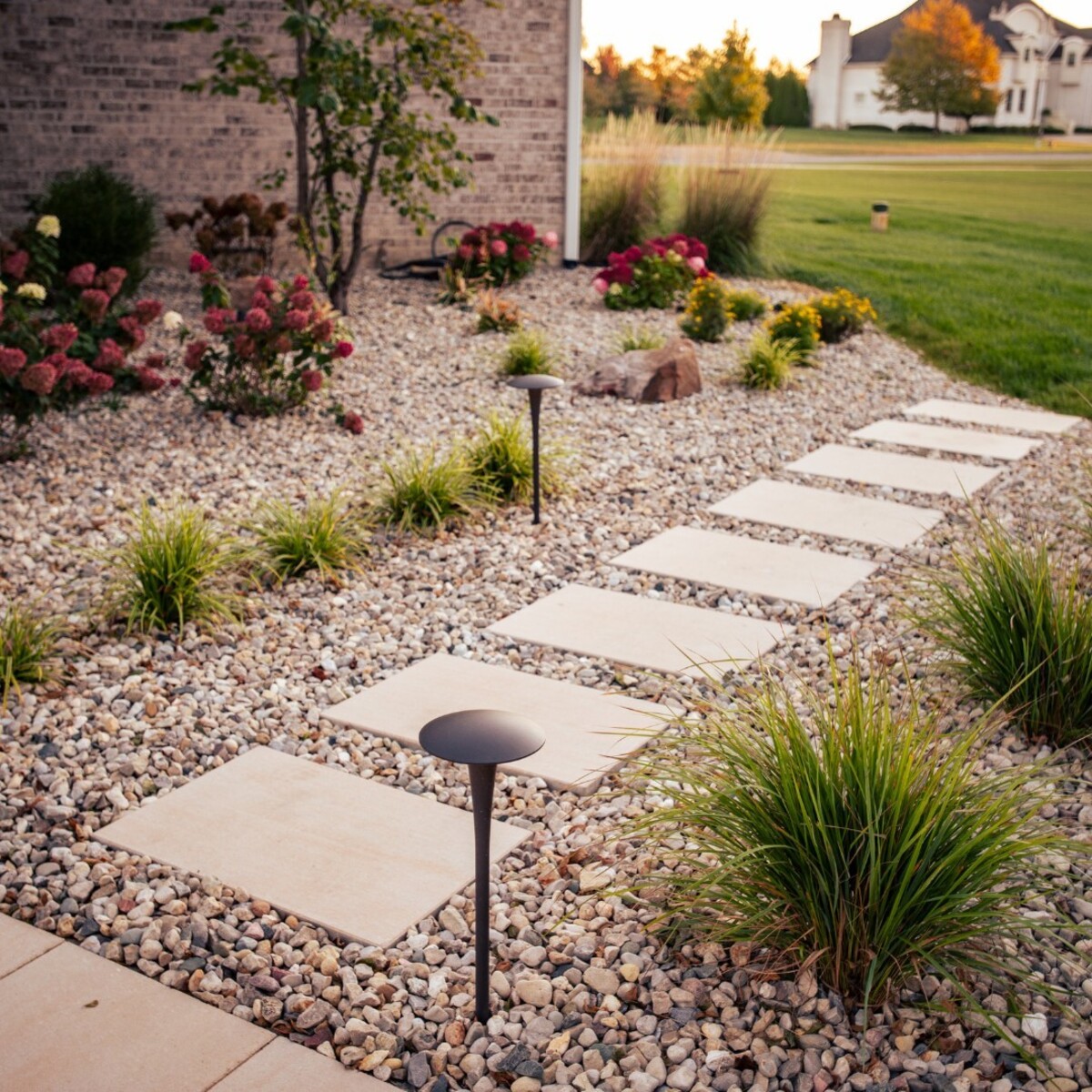
Are you looking for a low-maintenance garden design?
The easiest way to achieve it is to use materials that also add visual interest, such as mulch or gravel.
Pebbles, gravel, and river stones in various shapes, sizes, and colors will create a ground cover that will keep the weeds away and add appeal to the garden.
A Path Leading To The Gate
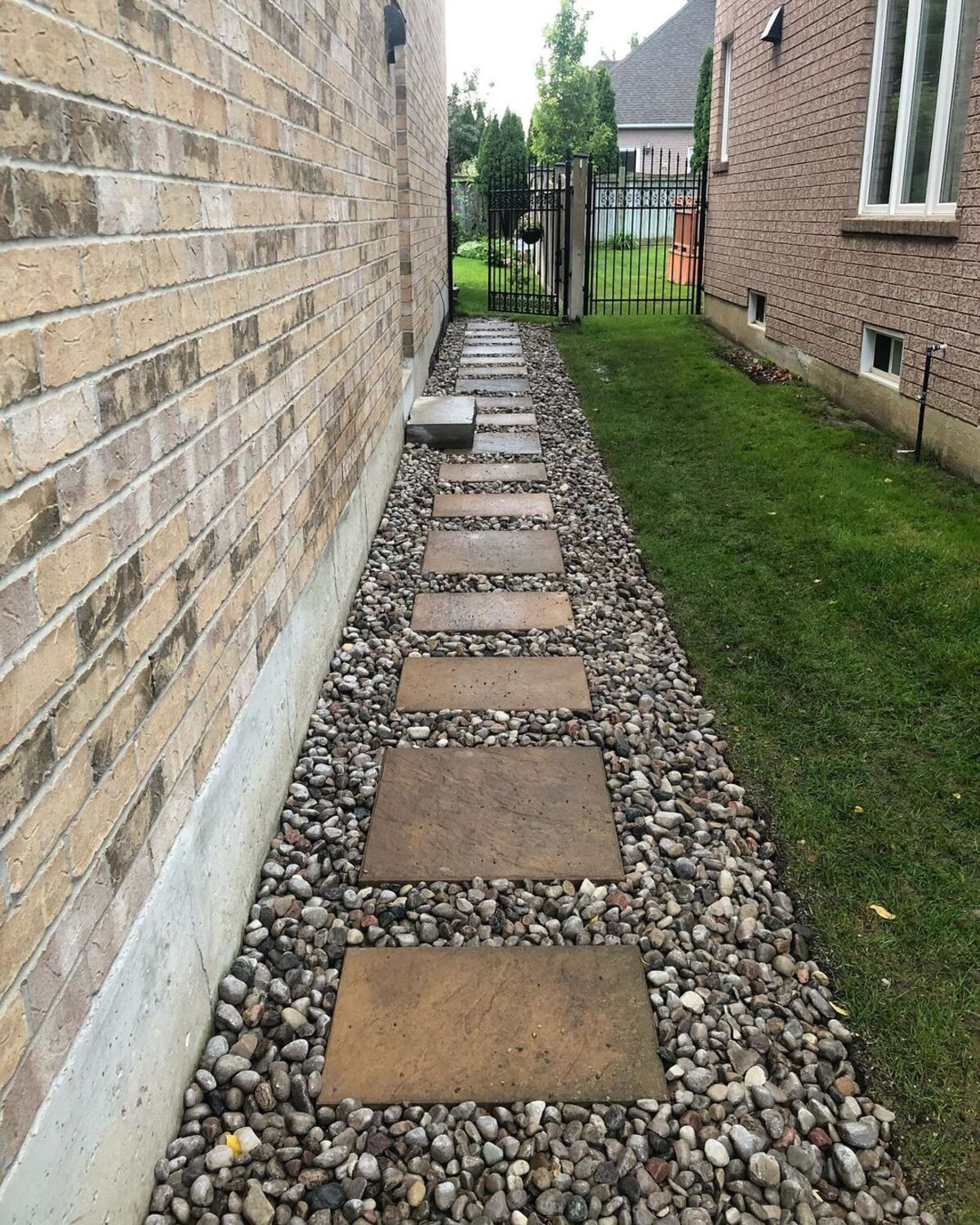
Walkways are an important part of the landscape.
In addition to directing the traffic to a certain area, walkways also create interest and differentiate zones in the backyard.
River rocks are preferred in the design of walkways for many reasons.
They can be gathered for free, they create a whimsical look, and they are very durable.
Curved Garden Edge With River Stones
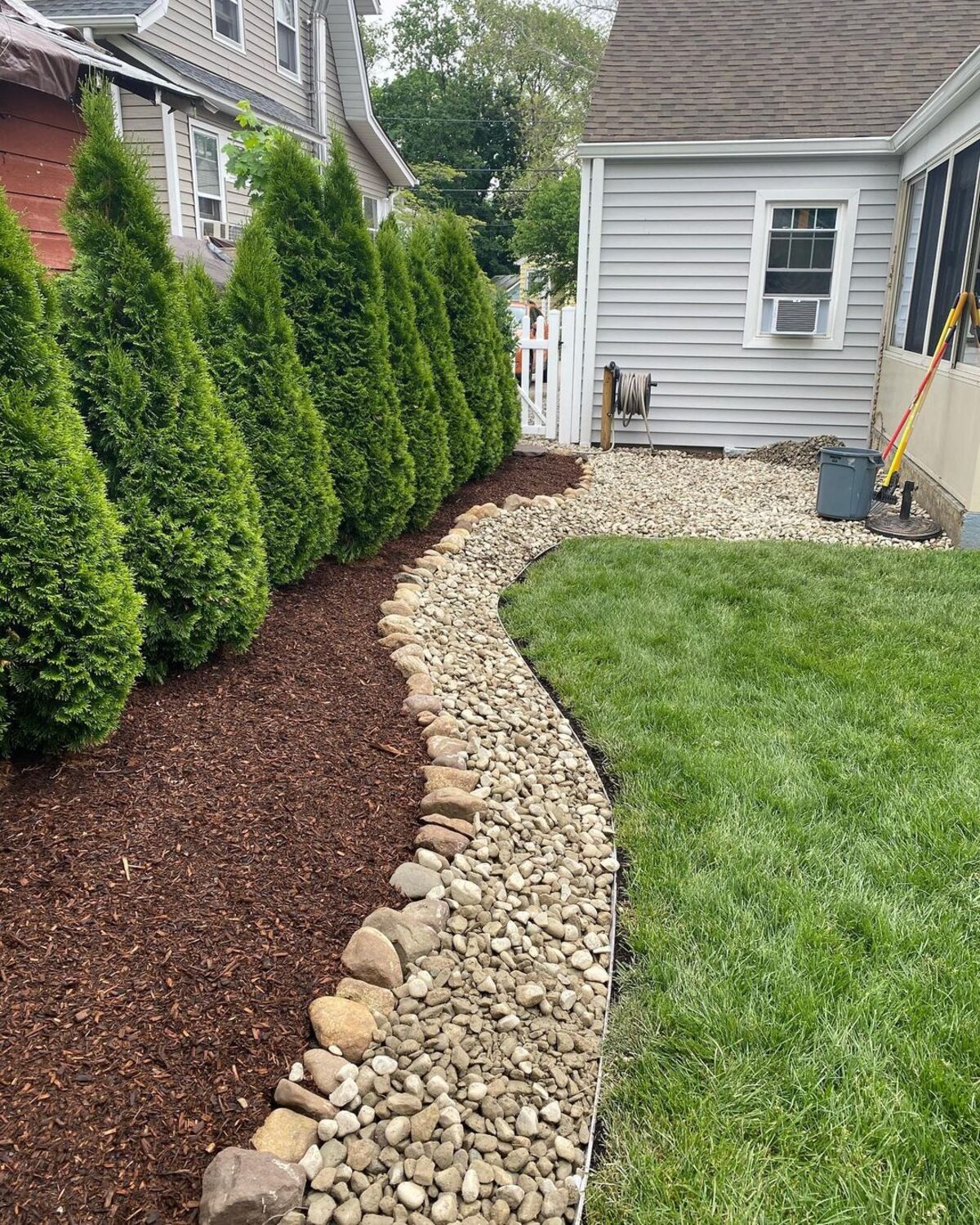
@goodman_landscape_contractors
Create a unique garden bed by combining natural materials such as mulch, river rocks, and grass in a pattern.
Mulch acts as a ground cover that limits the growth of weeds.
The river rock line defines the border of the garden bed and differentiates it from the maintained lawn.
Dry Creek From A Fountain
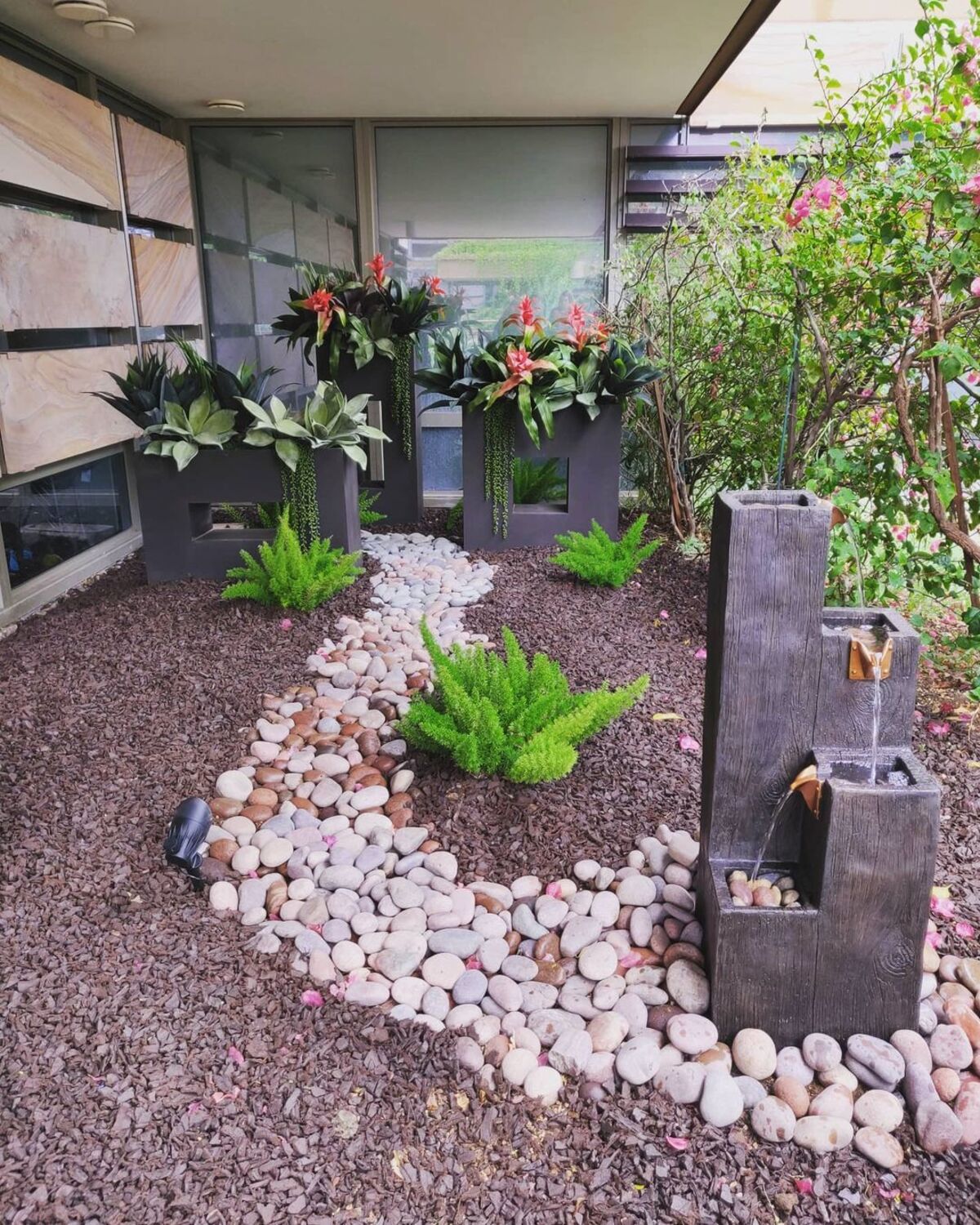
River rocks are usually used in garden water features.
If you do not have space to make a pond or a fountain from stacked stones, you can install a store-bought fountain and surround it with gravel and river rocks, which will blend the artificial fountain with the natural landscape.


